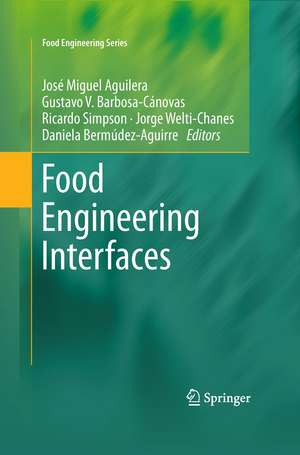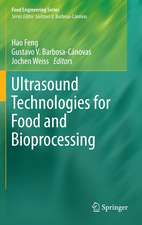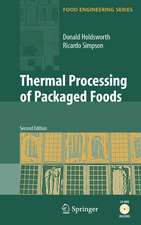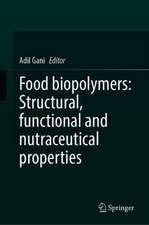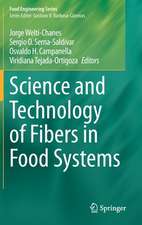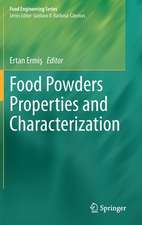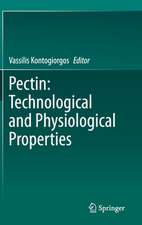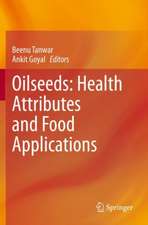Food Engineering Interfaces: Food Engineering Series
Editat de José Miguel Aguilera, Ricardo Simpson, Jorge Welti-Chanes, Daniela Bermudez Aguirre, Gustavo Barbosa-Canovasen Limba Engleză Paperback – 31 ian 2013
| Toate formatele și edițiile | Preț | Express |
|---|---|---|
| Paperback (1) | 1236.38 lei 6-8 săpt. | |
| Springer – 31 ian 2013 | 1236.38 lei 6-8 săpt. | |
| Hardback (1) | 1243.29 lei 6-8 săpt. | |
| Springer – 22 dec 2010 | 1243.29 lei 6-8 săpt. |
Din seria Food Engineering Series
- 18%
 Preț: 980.95 lei
Preț: 980.95 lei - 15%
 Preț: 642.51 lei
Preț: 642.51 lei - 15%
 Preț: 647.92 lei
Preț: 647.92 lei - 23%
 Preț: 856.71 lei
Preț: 856.71 lei - 15%
 Preț: 647.40 lei
Preț: 647.40 lei - 15%
 Preț: 646.30 lei
Preț: 646.30 lei -
 Preț: 384.86 lei
Preț: 384.86 lei - 18%
 Preț: 966.78 lei
Preț: 966.78 lei - 15%
 Preț: 656.74 lei
Preț: 656.74 lei - 15%
 Preț: 653.33 lei
Preț: 653.33 lei - 18%
 Preț: 951.59 lei
Preț: 951.59 lei - 18%
 Preț: 944.99 lei
Preț: 944.99 lei - 15%
 Preț: 716.15 lei
Preț: 716.15 lei - 18%
 Preț: 1232.57 lei
Preț: 1232.57 lei - 15%
 Preț: 647.92 lei
Preț: 647.92 lei - 15%
 Preț: 587.85 lei
Preț: 587.85 lei - 18%
 Preț: 1222.80 lei
Preț: 1222.80 lei - 18%
 Preț: 952.09 lei
Preț: 952.09 lei - 18%
 Preț: 1398.31 lei
Preț: 1398.31 lei -
 Preț: 399.12 lei
Preț: 399.12 lei - 18%
 Preț: 954.14 lei
Preț: 954.14 lei - 15%
 Preț: 644.95 lei
Preț: 644.95 lei - 18%
 Preț: 968.65 lei
Preț: 968.65 lei - 15%
 Preț: 638.89 lei
Preț: 638.89 lei - 18%
 Preț: 962.49 lei
Preț: 962.49 lei - 18%
 Preț: 1008.25 lei
Preț: 1008.25 lei - 18%
 Preț: 1225.79 lei
Preț: 1225.79 lei - 18%
 Preț: 961.41 lei
Preț: 961.41 lei - 18%
 Preț: 1378.86 lei
Preț: 1378.86 lei - 18%
 Preț: 961.72 lei
Preț: 961.72 lei -
 Preț: 489.30 lei
Preț: 489.30 lei - 18%
 Preț: 1388.05 lei
Preț: 1388.05 lei - 18%
 Preț: 1235.08 lei
Preț: 1235.08 lei - 15%
 Preț: 643.34 lei
Preț: 643.34 lei - 18%
 Preț: 2109.71 lei
Preț: 2109.71 lei - 18%
 Preț: 1815.87 lei
Preț: 1815.87 lei - 15%
 Preț: 644.95 lei
Preț: 644.95 lei - 18%
 Preț: 957.32 lei
Preț: 957.32 lei - 18%
 Preț: 973.06 lei
Preț: 973.06 lei
Preț: 1236.38 lei
Preț vechi: 1507.77 lei
-18% Nou
Puncte Express: 1855
Preț estimativ în valută:
236.61€ • 256.92$ • 198.75£
236.61€ • 256.92$ • 198.75£
Carte tipărită la comandă
Livrare economică 22 aprilie-06 mai
Preluare comenzi: 021 569.72.76
Specificații
ISBN-13: 9781461427872
ISBN-10: 1461427878
Pagini: 712
Ilustrații: XVIII, 694 p.
Dimensiuni: 155 x 235 x 37 mm
Greutate: 0.98 kg
Ediția:2011
Editura: Springer
Colecția Springer
Seria Food Engineering Series
Locul publicării:New York, NY, United States
ISBN-10: 1461427878
Pagini: 712
Ilustrații: XVIII, 694 p.
Dimensiuni: 155 x 235 x 37 mm
Greutate: 0.98 kg
Ediția:2011
Editura: Springer
Colecția Springer
Seria Food Engineering Series
Locul publicării:New York, NY, United States
Public țintă
ResearchCuprins
I. Selected Topics in Food Engineering.- 1. The Beginning, Current and Future of Food Engineering: A Perspective.- 2. Advances in 3D Numerical Simulation of Viscous and Viscoelastic Mixing Flows.- 3. CFD: An Innovative and Effective Design Tool for the Food Industry.- 4. Incorporation of Fibers in Foods: A Food Engineering Challenge.- 5. Gastric Digestion of Foods: Mathematical Modeling of Flow Field in a Human Stomach.- 6. State of the Art in Immobilized/Encapsulated Cell Technology in Fermentation Processes.- 7.Multi-Factorial Assessment of Microbial Risks in Foods: Merging Engineering, Science and Social Dimensions.- 8.Development of Eco-Efficiency Indicators to Assess the Environmental Performance of the Canadian Food and Beverage Industry.- 9. Food Process Economics.- 10. Systemic Approach to Curriculum Design and Development.- II. Advances in Food Process Engineering.- 11. Innovations in Thermal Treatment of Food.- 12. Optimization of Food Thermal Processing: Sterilization Stage and Plant Production Scheduling.- 13. Recent Advances in Emerging Nonthermal Technologies.- 14. High-Pressure Induced Effects on Bacterial Spores, Vegetative Microorganisms and Enzymes.- 15. High Pressure Sterilization of Foods.- 16. Bioseparation of Nutraceuticals Using Supercritical Carbon Dioxide.- 17. Mass Transfer and Equilibrium Parameters on High-Pressure CO2 Extraction of Plant Essential Oils.- III. Water Management in Food.- 18. Glass Transitions: Opportunities and Challenges.- 19. Caking of Water-soluble Amorphous and Crystalline Food Powders.- 20. Effective Drying Zones and Non-Linear Dynamics in a Laboratory Spray Dryer.- 21. Rehydration Modeling of Food Particulates Utilizing Principles of Water Transport in Porous Media.- 22. Responses of Living Organisms to Freezing and Drying: Potential Applications in Food Technology.- IV. Food Microstructure.- 23. Food Microstructures for Health, Wellbeing, and Pleasure.- 24. Fruit Microstructure Evaluation Using Synchrotron X-ray Computed Tomography.- 25. Multifractal Characterization of Apple Pore and Ham Fat-Connective Tissue Size Distributions Using Image Analysis.- V. Food Packaging.- 26. New Packaging Materials Based on Renewable Resources: Properties, Applications and Prospects.- 27. Edible Coatings to Improve Food Quality and Safety.- 28. Physical Properties of Edible Gelatin Films Colored with Chlorophyllide.
Textul de pe ultima copertă
Food Engineering Interfaces is based on invited presentations from the 10th International Congress on Engineering and Food (ICEF 10) held in Viña del Mar, Chile in April 2008. Published as part of Springer’s Food Engineering Series, the book includes 28 chapters contributed by world leaders in food engineering and related disciplines. Topics include the food engineering world through the years, advanced thermal and nonthermal processing of food, the modeling of gastric digestion, applications of CFD in food processing, food safety engineering, food engineering economics, incorporation of fibers into foods, bioseparation of nutraceuticals, supercritical fluid extraction of essential oils, caking of food powders, advances in food microstructure analysis, and food packaging.Aimed at the food industry and academia, this book is an excellent resource for anyone interested in the state of the art and the upcoming developments in food engineering, where health and well-being are central.
Caracteristici
Food engineers must be prepared to perform in their normal activities and to engage in new challenges and opportunities to make the profession more attractive and able to create a larger impact. Food engineers integrate developments in physics, chemistry, nutrition, informatics, material sciences, genomics (and other -omics), quality and safety, consumer behavior and gastronomy. Interfaces with the environment, the business sector, and regulations and export markets are considered. Includes supplementary material: sn.pub/extras
